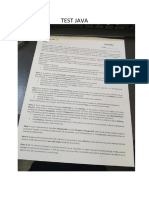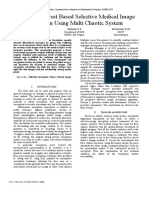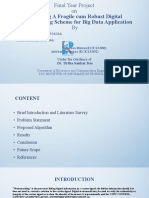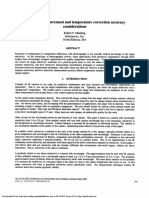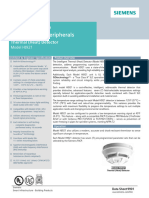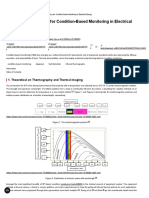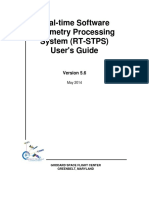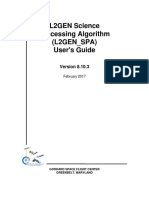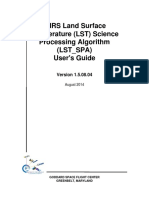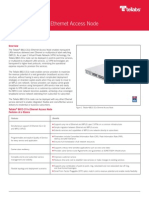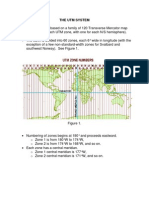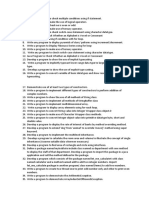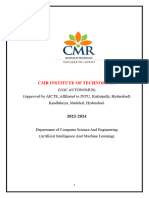VIIRS 375m Active Fire Science Processing Algorithm (VFIRE375 - SPA) User's Guide
VIIRS 375m Active Fire Science Processing Algorithm (VFIRE375 - SPA) User's Guide
Uploaded by
Nithindev GuttikondaCopyright:
Available Formats
VIIRS 375m Active Fire Science Processing Algorithm (VFIRE375 - SPA) User's Guide
VIIRS 375m Active Fire Science Processing Algorithm (VFIRE375 - SPA) User's Guide
Uploaded by
Nithindev GuttikondaOriginal Title
Copyright
Available Formats
Share this document
Did you find this document useful?
Is this content inappropriate?
Copyright:
Available Formats
VIIRS 375m Active Fire Science Processing Algorithm (VFIRE375 - SPA) User's Guide
VIIRS 375m Active Fire Science Processing Algorithm (VFIRE375 - SPA) User's Guide
Uploaded by
Nithindev GuttikondaCopyright:
Available Formats
VIIRS 375m Active Fire
Science Processing
Algorithm (VFIRE375_SPA)
User's Guide
Version 2.5.1
May 2017
GODDARD SPACE FLIGHT CENTER
GREENBELT, MARYLAND
VIIRS 375m Active Fire Science Processing Algorithm
VFIRE375_SPA
General
The NASA Goddard Space Flight Center’s (GSFC) Direct Readout Laboratory (DRL), Code
606.3 developed this software for the International Polar Orbiter Processing Package
(IPOPP). IPOPP maximizes the utility of Earth science data for making real-time decisions
by giving fast access to instrument data and derivative products from the Suomi National
Polar-orbiting Partnership (SNPP), Aqua, and Terra missions and, in the future, the Joint Polar
Satellite System (JPSS) mission.
Users must agree to all terms and conditions in the Software Usage Agreement on the DRL
Web Portal before downloading this software.
Software and documentation published on the DRL Web Portal may occasionally be updated
or modified. The most current versions of DRL software are available at the DRL Web Portal:
http://directreadout.sci.gsfc.nasa.gov/?id=software
Questions relating to the contents or status of this software and its documentation should be
addressed to the DRL via the Contact DRL mechanism at the DRL Web Portal:
http://directreadout.sci.gsfc.nasa.gov/?id=dspContent&cid=66
Algorithm Wrapper Concept
The DRL has developed an algorithm wrapper to provide a common command and execution
interface to encapsulate multi-discipline, multi-mission science processing algorithms. The
wrapper also provides a structured, standardized technique for packaging new or updated
algorithms with minimal effort.
A Science Processing Algorithm (SPA) is defined as a wrapper and its contained algorithm.
SPAs will function in a standalone, cross-platform environment to serve the needs of the broad
Direct Readout community. Detailed information about SPAs and other DRL technologies is
available at the DRL Web Portal.
Software Description
This software package contains the Visible Infrared Imaging Radiometer Suite (VIIRS) 375m
Active Fire Science Processing Algorithm (VFIRE375_SPA). This algorithm primarily uses
brightness temperatures derived from bands I04 and I05 to detect fires. The algorithm takes
as input VIIRS 375m Science Data Record (SDR) files, along with the associated terrain-
corrected geolocation file, and identifies active fires. Additionally, the algorithm also takes as
input VIIRS M13 and IVCDB SDR files, along with the associated terrain-corrected
geolocation file, for land/water mask purposes and in order to process nighttime data located
over the South Atlantic Anomaly. The outputs are a two-dimensional fire mask in Hierarchical
Data Format (HDF) and a fire location text file. The SPA functions in two modes: standalone,
or as an IPOPP plug-in.
VFIRE375_SPA Page 1 May 2017
Software Version
Version 1.7 of the DRL algorithm wrapper was used to package the SPA described in this
document. The SPA uses version 2.5.1 of the VFIRE375 algorithm.
Enhancements to this SPA include:
land/water mask implementation in the VFIRE375 HDF outputs;
implementation of Fire Radiative Power (FRP) in both VFIRE375 HDF and Fire
Location text file outputs;
enhanced time and geolocation attributes in the VFIRE375 HDF outputs;
update to version 2.5.1 of the VFIRE375 algorithm.
This software will execute on a 64-bit computer and has been tested on computers with 32GB
of RAM, with the following operating systems:
a) Fedora 24 X86_64;
b) CentOS Linux 7 X86_64;
c) OpenSUSE Linux 13.2 X86_64;
d) Kubuntu 14.04 X86_64.
Copyright 1999-2007, United States Government as represented by the Administrator for the
National Aeronautics and Space Administration. All Rights Reserved.
Credits
The VFIRE375 SPA was developed by the NASA Land Science Team in collaboration with
the DRL at NASA/GSFC. The software conforms with the International Land Direct Readout
Coordinating Committee (ILDRCC) data requirements.
Prerequisites
To run this package, you must have the Java Development Kit (JDK) or Java Runtime
Engine (JRE) (Java 1.6.0_25 or higher) installed on your computer, and have the Java
installation bin/ subdirectory in your PATH environment variable. This package contains 64-
bit binaries statically pre-compiled on an x86-compatible 64-bit computer running under
CentOS 7, using gcc 4.5.1.
Program Inputs and Outputs
The VFIRE375 algorithm takes as input VIIRS I01, I02, I03, I04, I05, M13, and IVCDB SDRs,
and I-band and M-band terrain-corrected geolocation HDF5 files. The algorithm outputs the
VIIRS 375m Active Fires HDF file and the Fire Location text file.
The Fire Location 375m text file is output when fire detections are present in the VFIRE375
HDF output. This text file contains information about each fire pixel detected by the SPA. Each
line represents one fire pixel and has the following seven columns, separated by commas, for
example:
VFIRE375_SPA Page 2 May 2017
22.86469,-81.37183,367.0,0.4,0.4,7,78.7
The table below describes each column in detail. The information contained in this table was
obtained from http://viirsfire.geog.umd.edu/pages/iband.php and from the
vfire375_users_guide.pdf file packaged with the VFIRE375_SPA.
Column Column Description Units Possible Values
Number
1 Fire pixel latitude Degrees Range: -90.00000 to 90.00000
2 Fire pixel longitude Degrees Range: -180.00000 to 180.00000
3 Fire pixel channel I4 Kelvin Range: 208 to 367
brightness
temperature Brightness temperature values from channel I4.
There is a typical saturation condition where the fire
pixel is assigned the nominal saturation temperature
of 367 K. Also, there are extreme cases where a fire
detection will greatly exceed the resolvable
brightness temperature in channel I4, causing the fire
pixel’s Digital Number (DN) to fold over and show an
abnormally low temperature which can be confronted
by the companion long-wave infrared channel I5
data.
4 Fire pixel size along Kilometers Range: 0.3 to 0.8, for both along the scan nadir and
the scan nadir along the track nadir.
5 Fire pixel size along Kilometers Fire pixel size is a function of scan angle from nadir:
the track nadir At 0 (nadir) to ±31.59 degrees scan angle, three
native pixels are aggregated over the radiance
domain to form one effective sample. In the second
image section extending from ±31.59 to ±44.68
degrees scan angle, two native pixels are
aggregated to form one effective sample, and finally
in the third image section extending from ±44.68
degrees to the maximum scan angle (±56.06
degrees), no aggregation is performed and one
native pixel represents one effective sample.
6 Fire pixel detection n/a 7 = Low confidence fire pixel. During daytime, these
confidence are typically due to areas of sun glint and lower
relative temperature anomalies (< 15K) in the mid-
infrared channel I4. During nighttime, these only
occur over the region of the South Atlantic Magnetic
Anomaly (from 11°E to 110°W and 7°E to 55°S),
which can cause spurious brightness temperatures in
the mid-infrared channel I4 and lead to potential false
alarms.
8 = Nominal confidence fire pixel. These are free of
potential sun glint during daytime, and marked by
strong (> 15K) temperature anomalies in either
VFIRE375_SPA Page 3 May 2017
daytime or nighttime.
9 = High confidence fire pixel. In both daytime and
nighttime, these are saturated pixels which include
nominal saturation and DN folding (i.e., pixels that
greatly exceed the saturation temperature causing
the DN value to fold over).
7 Fire pixel radiative Megawatts Variable: non-zero positive floating-point value (> 0.0
power MW). Fire Radiative Power (FRP) is a measure of
the rate of radiant heat output from a fire. It has been
demonstrated in small-scale experimental fires that
the FRP of a fire is related to the rate at which fuel is
being consumed and smoke emissions released.
Please note that the Fire Location text file is not generated if no fire pixels are detected for
the datasets processed. When running in Standalone Mode, the VFIRE375_SPA will
terminate with a message similar to the following when no Fire Location text file is generated:
Output viirs.activefires375 is /home/ipopp/drl/SPA/VFIRE375/testdata/output/VF375.hdf
Output viirs.fireloc375 is null
Installation and Configuration
Installing as a Standalone Application:
Download the VFIRE375_2.5.1_SPA_1.7.tar.gz and
VFIRE375_2.5.1_SPA_1.7_testdata.tar.gz (optional) files into the same directory.
Decompress and un-archive the VFIRE375_2.5.1_SPA_1.7.tar.gz and
VFIRE375_2.5.1_SPA_1.7_testdata.tar.gz (optional) files:
$ tar -xzf VFIRE375_2.5.1_SPA_1.7.tar.gz
$ tar -xzf VFIRE375_2.5.1_SPA_1.7_testdata.tar.gz
This will create the following subdirectories:
SPA
VFIRE375
algorithm
ancillary
station
testdata
testscripts
wrapper
VFIRE375_SPA Page 4 May 2017
Installing into an IPOPP Framework: This SPA can also be installed dynamically into an
IPOPP framework to automate production of VIIRS 375m Active Fires and Fire Location text
file data products. The SPA installation process will install its SPA service(s) into IPOPP. An
SPA service is an IPOPP agent that provides the mechanism necessary for running an SPA
automatically within the IPOPP framework. Once this SPA is installed, users must enable the
SPA service(s) corresponding to this SPA along with any other prerequisite SPA service(s).
Instructions for installing an SPA and enabling its services are contained in the IPOPP User’s
Guide (available on the DRL Web Portal). The SPA services associated with this SPA are
listed in Appendix A.
Software Package Testing and Validation
The testscripts subdirectory contains test scripts that can be used to verify that your current
installation of the SPA is working properly, as described below. Note that the optional
VFIRE375_2.5.1_SPA_1.7_testdata.tar.gz file is required to execute these testing
procedures.
Step 1: cd into the testscripts directory.
Step 2: There is a script named run-VFIRE375.sh inside the testscripts directory.
To run the VFIRE375 algorithm, use
$ ./run-VFIRE375.sh
A successful execution usually requires 1 minute or more, depending on the speed of your
computer and the size of the input. If everything is working properly, the scripts will terminate
with a message such as:
Output viirs.activefires375 is /home/ipopp/drl/SPA/VFIRE375/testdata/output/VF375.hdf
Output viirs.fireloc375 is /home/ipopp/drl/SPA/VFIRE375/testdata/output/FireLoc375.txt
You can cd to the output directory to verify that the science products exist. Test output
product(s) are available for comparison in the testdata/output directory. These test output
product(s) were generated on a 64-bit PC architecture computer running CentOS 7. The
output products serve as an indicator of expected program output. Use a comparison utility
(such as diff, hdiff, etc.) to compare your output product(s) to those provided in the
testdata/output directory. Locally generated files may differ slightly from the provided output
files because of differences in machine architecture or operating systems.
If there is a problem and the code terminates abnormally, the problem can be identified using
the log files. Log files are automatically generated within the directory used for execution.
They start with stdfile* and errfile*. Other log and intermediate files may be generated
automatically within the directory used for execution. They are useful for traceability and
debugging purposes. However it is strongly recommended that users clean up log files and
intermediate files left behind in the run directory before initiating a fresh execution of the SPA.
Intermediate files from a previous run may affect a successive run and produce ambiguous
results. Please report any errors that cannot be fixed to the DRL.
VFIRE375_SPA Page 5 May 2017
Program Operation
In order to run the package using your own input data, you can either use the run scripts within
the wrapper subdirectories, or modify the test scripts within the testscripts subdirectory.
To Use the Run Script
Identify the 'run' script: The wrapper directory within this package contains one subdirectory
named VFIRE375. The subdirectory contains an executable called 'run'. Execute 'run' within
the correct wrapper subdirectory to generate the corresponding product. For instance, the
'run' within wrapper/VFIRE375 is used for creating VFIRE375 outputs. Note that to execute
'run', you need to have java on your path.
Specify input parameters using <label value> pairs: To execute the 'run' scripts, you must
supply the required input and output parameters. Input and output parameters are usually file
paths or other values (e.g., an automatic search flag). Each parameter is specified on the
command line by a <label value> pair. Labels are simply predefined names for parameters.
Each label must be followed by its actual value. Each process has its own set of <label value>
pairs that must be specified in order for it to execute. The two types of <label value> pairs that
the VFIRE375_SPA uses are:
a) Input file label/values. These are input file paths. Values are absolute or relative paths
to the corresponding input file.
b) Output file label/values. These are output files that are produced by the SPA. Values
are absolute or relative paths of the files you want to generate.
The following tables contain labels, and their descriptions, required by the VFIRE375_SPA.
Input File Labels Description Source
viirs.gitco VIIRS I-Band Terrain-Corrected
1. The C-SDR_SPA may be used to create
Geolocation input HDF file path
these products.
viirs.svi01 VIIRS 375m I01 band SDR input 2. Real time products over the eastern US
HDF file path region are available from the DRL ftp site at:
ftp://is.sci.gsfc.nasa.gov/gsfcdata/npp/viirs/l
viirs.svi02 VIIRS 375m I02 band SDR input evel1/<GITCO|SVIxx|GMTCO|SVM13|IVC
HDF file path DB>_npp
_dyyyymmdd_thhmmssS_ehhmmssS*.h5
viirs.svi03 VIIRS 375m I03 band SDR input
HDF file path Where yyyy, mm, dd represents the year,
month, and day of month for the start of the
viirs.svi04 VIIRS 375m I04 band SDR input swath; the first hh, mm, ss, S represents the
HDF file path hour, minutes, seconds, and 10th of a
second for the start of the swath and the
viirs.svi05 VIIRS 375m I05 band SDR input second hh, mm, ss, S represents the end
HDF file path time of the swath. (xx = 01 to 05)
3. VIIRS I-Band SDR, I-Band Terrain-
viirs.gmtco VIIRS M-Band Terrain-Corrected Corrected Geolocation, M-Band SDR, and
Geolocation input HDF file path M-Band Terrain-Corrected Geolocation
VFIRE375_SPA Page 6 May 2017
Input File Labels Description Source
viirs.svm13 VIIRS 750m M13 band SDR input products for other locations and times are
HDF file path available for download at
www.class.noaa.gov
viirs.ivcdb VIIRS Calibrator Dual-Gain IP
input HDF file path
Output File Labels Description Output Format Description
viirs.activefires375 VIIRS 375m Active Fires output HDF file Please refer to the
path “vfire375_users_guide.pdf” document in
the algorithm/docs/ directory within the
viirs.fireloc375 VIIRS 375m Fire Location output text file VFIRE375_SPA package
path
Execute the 'run': The following script shows an example of a command line to run the
VFIRE375 algorithm from the testscripts directory:
$ ../wrapper/VFIRE375/run \
viirs.gitco ../testdata/input/GITCO_npp_d20140901_t1738560_e1740201_b14746_c20140908200715043541_noaa_ops.h5 \
viirs.svi01 ../testdata/input/SVI01_npp_d20140901_t1738560_e1740201_b14746_c20140908200814185302_noaa_ops.h5 \
viirs.svi02 ../testdata/input/SVI02_npp_d20140901_t1738560_e1740201_b14746_c20140908200817203819_noaa_ops.h5 \
viirs.svi03 ../testdata/input/SVI03_npp_d20140901_t1738560_e1740201_b14746_c20140908200743066611_noaa_ops.h5 \
viirs.svi04 ../testdata/input/SVI04_npp_d20140901_t1738560_e1740201_b14746_c20140908200756074531_noaa_ops.h5 \
viirs.svi05 ../testdata/input/SVI05_npp_d20140901_t1738560_e1740201_b14746_c20140908200946032012_noaa_ops.h5 \
viirs.gmtco ../testdata/input/GMTCO_npp_d20140901_t1738560_e1740201_b14746_c20140908200702642321_noaa_ops.h5 \
viirs.svm13 ../testdata/input/SVM13_npp_d20140901_t1738560_e1740201_b14746_c20140908200931364181_noaa_ops.h5 \
viirs.ivcdb ../testdata/input/IVCDB_npp_d20140901_t1738548_e1740201_b14746_c20161004162415456000_ipop_dev.h5 \
viirs.activefires375 ../testdata/output/VF375.hdf \
viirs.fireloc375 ../testdata/output/FireLoc375.txt
A successful execution usually requires 1 minute or more, depending on the speed of your
computer and the size of the input. If execution fails, you will see an error message indicating
the cause of failure (e.g., a file cannot be found, or a label cannot be recognized). Correct it
and run again. If the problem has some other cause, it can be identified using the log files.
Log files are automatically generated within the directory used for execution. They start with
stdfile* and errfile* and can be deleted after execution. Other log and intermediate files may
be generated automatically within the directory used for execution. They are useful for
traceability and debugging purposes. However it is strongly recommended that users clean
up log files and intermediate files left behind in the run directory before initiating a fresh
execution of the SPA. Intermediate files from a previous run may affect a successive run and
produce ambiguous results. The 'run' can be executed from any directory the user chooses.
This can be done by prefixing it with the file path for the 'run' script.
NOTE: The data products generated by this SPA may be visualized with the DRL's H2G_SPA
(Hierarchical Data Format [HDF] to Georeferenced Tagged Image File Format [GeoTIFF]
Converter Science Processing Algorithm). H2G is designed specifically for Direct Readout
VFIRE375_SPA Page 7 May 2017
applications to create geolocated GeoTIFF images, jpeg browse images, and png browse
images for parameter datasets in SNPP products and EOS products. H2G_SPA and its User
Guide are available for download from the DRL Web Portal. Please refer to Appendix A for
information on enabling image production for this SPA in IPOPP.
To Use the Scripts in the testscripts Directory
One simple way to run the algorithms from the directory of your choice using your own data
is to copy the run_VFIRE375.sh script from the testscripts directory to the selected directory.
Change the values of the variables like WRAPPERHOME, INPUTHOME and OUTPUTHOME
to reflect the file paths of the wrapper directories and the input/output file paths. Then modify
the input/output file name variables. Run the script to process your data.
VFIRE375_SPA Page 8 May 2017
Appendix A
SPA Services
Installation of this SPA in IPOPP mode will make the SPA services listed in Table A-1 available
to IPOPP. These SPA services along with any other prerequisite SPA services (listed in Table
A-2) will need to be enabled to allow IPOPP to automate production of the VFIRE375_SPA
data products. The SPAs containing the prerequisite SPA services listed in Tables A-2 can
be downloaded from the DRL Web Portal, in case they are not already available in your IPOPP
installation. Details about these other SPAs are available in the respective SPA User's Guides.
Please refer to the IPOPP User’s Guide for instructions on how to install an SPA in IPOPP
and enable the corresponding SPA services.
Table A-1. SPA Services
SPA services for Data Products produced
this SPA
VFIRE375 Product Name Destination
(when installed in IPOPP)
VIIRS 375m Active Fires /raid/pub/gsfcdata/npp/viirs/level2/VF3
75_npp_dyyyymmdd_thhmmssS_ehh
mmssS*.hdf1
VIIRS 375m Fire Location Text File /raid/pub/gsfcdata/npp/viirs/level2/Fire
Loc375_npp_dyyyymmdd_thhmmssS_
ehhmmssS*.txt1
1
Where yyyy, mm, dd, hh represents the year, month and day of month for the start of the
swath; the first hh, mm, ss, S represents the hour, minutes, seconds and 10th of a second for
the start of the swath and the second hh, mm, ss, S represents the end time of the swath.
Table A-2. Prerequisite SPA services
Prerequisite SPA services SPA in which they are available
VIIRS_C-SDR C-SDR_SPA
or
VIIRS-SDR VIIRS-SDR_SPA
NOTE: The SPA services VIIRS-SDR and VIIRS_C-SDR must never be run simultaneously.
Table A-3. Image-generating SPA services
Image-generating SPA services SPA in which they are available
vfire375-geotiff H2G_SPA
NOTE: Please refer to the H2G_SPA User’s Guide for more details about the image products,
including their locations and filename patterns when they are generated in IPOPP.
VFIRE375_SPA Page A-1 May 2017
You might also like
- TEST JAVA CsieDocument31 pagesTEST JAVA CsieChristiana TomescuNo ratings yet
- Vfire375 3.0.0 Spa 1.9Document10 pagesVfire375 3.0.0 Spa 1.9guttikondanithindevNo ratings yet
- Richards 2004Document6 pagesRichards 2004g.kempeneersNo ratings yet
- 2018 04 16 Machine Learning&Deep LearningUseCasesDocument19 pages2018 04 16 Machine Learning&Deep LearningUseCaseskashif kashifNo ratings yet
- Weld TestDocument5 pagesWeld Testkoib789No ratings yet
- Avi Infrared Dataset Generation For People Detection Through Superimposition of Different ICCVW 2021 PaperDocument10 pagesAvi Infrared Dataset Generation For People Detection Through Superimposition of Different ICCVW 2021 Paperzenon7010No ratings yet
- Status of Cooled and Uncooled Infrared Detectors at SCD, IsraelDocument16 pagesStatus of Cooled and Uncooled Infrared Detectors at SCD, Israelmercy calloNo ratings yet
- 12947-Article Text-43438-1-10-20190306Document6 pages12947-Article Text-43438-1-10-20190306Vitaly KliucheniaNo ratings yet
- Final - EMBEDDED PROJECT REPORT-sample ReportDocument17 pagesFinal - EMBEDDED PROJECT REPORT-sample ReportAifa HazlinNo ratings yet
- Detect3D-for-Fire-and-Gas-Mapping-AnalysisDocument23 pagesDetect3D-for-Fire-and-Gas-Mapping-Analysisinstrumentsengineers2023No ratings yet
- Adaptive Infrared Non-Uniformity CorrectionDocument17 pagesAdaptive Infrared Non-Uniformity CorrectiondemetNo ratings yet
- ThermalImagingTech TN 0305-508Document2 pagesThermalImagingTech TN 0305-508Lealyn AbaoNo ratings yet
- RD Handbook PDFDocument48 pagesRD Handbook PDFManuelNo ratings yet
- Thermal Camera Implementation For Crack Detection in Pressure VesselsDocument5 pagesThermal Camera Implementation For Crack Detection in Pressure VesselsVinodNo ratings yet
- Resarch PaperDocument5 pagesResarch Paper18UCOS150 SS METHUNNo ratings yet
- Detailed Description of Fire Detection AlgorithmDocument9 pagesDetailed Description of Fire Detection AlgorithmUstmany EkoNo ratings yet
- Analysis of Fire Extinguisher Gauge Level Using OpenCVDocument2 pagesAnalysis of Fire Extinguisher Gauge Level Using OpenCVIJAERS JOURNALNo ratings yet
- Camera Calibration Updated Version4Dec2019Document7 pagesCamera Calibration Updated Version4Dec2019Anonymous AsYGKsjagNo ratings yet
- Research Paper 2Document4 pagesResearch Paper 218UCOS150 SS METHUNNo ratings yet
- Forest Fire Detection Using Image ProcessingDocument16 pagesForest Fire Detection Using Image ProcessingChilupuri Sreeya100% (1)
- Fire AlarmDocument28 pagesFire AlarmEdward BustamanteNo ratings yet
- Final SpeechDocument7 pagesFinal SpeechCharef WidedNo ratings yet
- Micronir Integration Time Reference Spectra Signal Strength Application Notes enDocument7 pagesMicronir Integration Time Reference Spectra Signal Strength Application Notes enLeo EspositoNo ratings yet
- Calibration of Uncooled Thermal Infrared CamerasDocument11 pagesCalibration of Uncooled Thermal Infrared Camerasing jyaNo ratings yet
- Ijece V10i5p104Document11 pagesIjece V10i5p104dat54636No ratings yet
- Fire Detection and Quenching System Using Image ProcessingDocument4 pagesFire Detection and Quenching System Using Image Processingjobinrs22022No ratings yet
- Development of A GSM-Based Smoke Detector and Temperature Monitoring System For Preventing Fire OutbreakDocument5 pagesDevelopment of A GSM-Based Smoke Detector and Temperature Monitoring System For Preventing Fire OutbreakInternational Journal of Innovative Science and Research TechnologyNo ratings yet
- Lecture 6 SPECTDocument32 pagesLecture 6 SPECTNguyen Thai HaNo ratings yet
- FinalReport HERMES OTA Project2Document44 pagesFinalReport HERMES OTA Project2daveNo ratings yet
- Region of Interest Based Selective Medical Image Encryption Using Multi Chaotic SystemDocument5 pagesRegion of Interest Based Selective Medical Image Encryption Using Multi Chaotic SystemVIVEK UPADHYAYANo ratings yet
- First Electro Optical System of The 21st CenturyDocument8 pagesFirst Electro Optical System of The 21st Centurybring it onNo ratings yet
- Efficient and Compact Convolutional Neural Network Architectures For Non-Temporal Real-Time Fire DetectionDocument6 pagesEfficient and Compact Convolutional Neural Network Architectures For Non-Temporal Real-Time Fire Detection48Nara Amit GopalNo ratings yet
- Efficient Deep Cnn-Based Fire Detection and Localization in Video Surveillance ApplicationsDocument11 pagesEfficient Deep Cnn-Based Fire Detection and Localization in Video Surveillance Applicationsvy23639105No ratings yet
- 2009 - Fire Detectionin Video Sequences Using A Generic Color ModelDocument12 pages2009 - Fire Detectionin Video Sequences Using A Generic Color ModelAntonio AntunovićNo ratings yet
- Detectors For Missile SeekersDocument10 pagesDetectors For Missile SeekersAhmed HamoudaNo ratings yet
- FFR Report Final PDFDocument13 pagesFFR Report Final PDFAbaidullah SajidNo ratings yet
- Digital Watermarking For Big DataDocument17 pagesDigital Watermarking For Big DataAnirban DasguptaNo ratings yet
- Emissivity Measurement and Temperature Correction Accuracy ConsiderationsDocument9 pagesEmissivity Measurement and Temperature Correction Accuracy ConsiderationsGiustNo ratings yet
- Infrared Physics & Technology: G.V. Ivanov, V.G. IvanovDocument5 pagesInfrared Physics & Technology: G.V. Ivanov, V.G. IvanovJhonStevenNavarroHNo ratings yet
- Fire Sentry FS24X Flame DetectorsDocument4 pagesFire Sentry FS24X Flame DetectorshdrNo ratings yet
- Laurent 2013 PerformanceDocument13 pagesLaurent 2013 Performancetaras.yakymchukNo ratings yet
- FLIR RD HandbookDocument52 pagesFLIR RD Handbooksemtex41100% (1)
- Flir I3 DatasheetDocument2 pagesFlir I3 DatasheetNanang FebriNo ratings yet
- Infrared ThermographyDocument20 pagesInfrared ThermographyMohamad Saad50% (2)
- Emissivity and AccuracyDocument9 pagesEmissivity and Accuracyalexander100% (1)
- HD Hi921Document5 pagesHD Hi921Mohammad FathiNo ratings yet
- A Study On Radar Target Detection Based On Deep Neural NetworksDocument4 pagesA Study On Radar Target Detection Based On Deep Neural NetworksMashal zehra100% (1)
- Enhancing Fire Detection Process Using Video Surveillance by Multi Expert SystemDocument5 pagesEnhancing Fire Detection Process Using Video Surveillance by Multi Expert SystemInternational Journal of Innovative Science and Research TechnologyNo ratings yet
- RS8500 Datasheet USDocument2 pagesRS8500 Datasheet UStranbien19021995No ratings yet
- KP 1018Ó ÎÄÌõÂëË Ã÷ÊéDocument15 pagesKP 1018Ó ÎÄÌõÂëË Ã÷ÊéAtiva InfoNo ratings yet
- Electrical System Inspection Theory and Thermal Signatures of ProblemsDocument12 pagesElectrical System Inspection Theory and Thermal Signatures of Problemsjide.atolagbe3737No ratings yet
- Image Processing Based Fire Detection System Using PiDocument3 pagesImage Processing Based Fire Detection System Using PiAmbareeshNo ratings yet
- IPTC-19714-MS Deep Learning For Monitoring Well Testing Burner EfficiencyDocument7 pagesIPTC-19714-MS Deep Learning For Monitoring Well Testing Burner Efficiency叶芊No ratings yet
- DiscoursDocument5 pagesDiscoursCharef WidedNo ratings yet
- Depth Resolution Enhancement in Time-of-FlightDocument9 pagesDepth Resolution Enhancement in Time-of-Flightweikanglai99No ratings yet
- P25 Datasheet PDFDocument2 pagesP25 Datasheet PDFHoang Diep PhanNo ratings yet
- Using An Infrared Library On Arduino: Search AdafruitDocument8 pagesUsing An Infrared Library On Arduino: Search Adafruitkamote_fritoNo ratings yet
- Sensors 22 08512 v3Document21 pagesSensors 22 08512 v3S. Murtaza Hussain 30No ratings yet
- Interior Lighting: Fundamentals, Technology and ApplicationFrom EverandInterior Lighting: Fundamentals, Technology and ApplicationNo ratings yet
- Modelling the Wireless Propagation Channel: A simulation approach with MATLABFrom EverandModelling the Wireless Propagation Channel: A simulation approach with MATLABNo ratings yet
- VIIRS Vegetation Index (VI) Science Processing Algorithm (VEGINDEX - SPA) User's GuideDocument8 pagesVIIRS Vegetation Index (VI) Science Processing Algorithm (VEGINDEX - SPA) User's GuideNithindev GuttikondaNo ratings yet
- VIIRS Active Fires Science Processing Algorithm (Viirs-Af - Spa) User's GuideDocument9 pagesVIIRS Active Fires Science Processing Algorithm (Viirs-Af - Spa) User's GuideNithindev GuttikondaNo ratings yet
- VIIRS Surface Reflectance Science Processing Algorithm (Surfreflect - Spa) User's GuideDocument11 pagesVIIRS Surface Reflectance Science Processing Algorithm (Surfreflect - Spa) User's GuideNithindev GuttikondaNo ratings yet
- Snow Cover Science Processing Algorithm (Snowcov - Spa) User's GuideDocument9 pagesSnow Cover Science Processing Algorithm (Snowcov - Spa) User's GuideNithindev GuttikondaNo ratings yet
- RT-STPS 5.6 Users Guide PDFDocument54 pagesRT-STPS 5.6 Users Guide PDFNithindev GuttikondaNo ratings yet
- Marching Orbit For Oceansat-3: Indian National Centre For Ocean Information Services (INCOIS) HyderabadDocument15 pagesMarching Orbit For Oceansat-3: Indian National Centre For Ocean Information Services (INCOIS) HyderabadNithindev GuttikondaNo ratings yet
- L2GEN Science Processing Algorithm (L2GEN - SPA) User's Guide: February 2017Document16 pagesL2GEN Science Processing Algorithm (L2GEN - SPA) User's Guide: February 2017Nithindev GuttikondaNo ratings yet
- VIIRS Cloud Optical Properties Science Processing Algorithm (COP - SPA) User's GuideDocument10 pagesVIIRS Cloud Optical Properties Science Processing Algorithm (COP - SPA) User's GuideNithindev GuttikondaNo ratings yet
- Modis Level 2 Imapp Atmospheric Science Processing Algorithm (Imapp - Spa) User's GuideDocument16 pagesModis Level 2 Imapp Atmospheric Science Processing Algorithm (Imapp - Spa) User's GuideNithindev GuttikondaNo ratings yet
- OMPSNADIR Science Processing Algorithm (Ompsnadir - Spa) User's GuideDocument12 pagesOMPSNADIR Science Processing Algorithm (Ompsnadir - Spa) User's GuideNithindev GuttikondaNo ratings yet
- VIIRS Land Surface Temperature (LST) Science Processing Algorithm (LST - SPA) User's GuideDocument9 pagesVIIRS Land Surface Temperature (LST) Science Processing Algorithm (LST - SPA) User's GuideNithindev GuttikondaNo ratings yet
- Tellabs - 8813-311v Ethernet Access NodeDocument3 pagesTellabs - 8813-311v Ethernet Access NodeNithindev GuttikondaNo ratings yet
- Active Fires Science Processing Algorithm (Activefires - Spa) User's GuideDocument8 pagesActive Fires Science Processing Algorithm (Activefires - Spa) User's GuideNithindev GuttikondaNo ratings yet
- Telnet CommandsDocument9 pagesTelnet CommandsNithindev GuttikondaNo ratings yet
- Advertisement Rec Jan 14Document7 pagesAdvertisement Rec Jan 14Nithindev GuttikondaNo ratings yet
- Previouspapers Shayak Radio Adhikari Screening Exam 2011 ElectronicsCommunicationDocument22 pagesPreviouspapers Shayak Radio Adhikari Screening Exam 2011 ElectronicsCommunicationNithindev GuttikondaNo ratings yet
- VIIRS Cloud Mask Science Processing Algorithm (Cloudmask - Spa) User's GuideDocument10 pagesVIIRS Cloud Mask Science Processing Algorithm (Cloudmask - Spa) User's GuideNithindev GuttikondaNo ratings yet
- Online Student Information-2014Document1 pageOnline Student Information-2014Nithindev GuttikondaNo ratings yet
- Utm UpsDocument5 pagesUtm UpsNithindev GuttikondaNo ratings yet
- Sowji Java LabDocument43 pagesSowji Java Labpagoti mohanraoNo ratings yet
- JPR Practical ProgramDocument2 pagesJPR Practical ProgramHiteshR 10b39No ratings yet
- C# Unit III NotesDocument20 pagesC# Unit III Notesvishalj1006No ratings yet
- B.Sc-III NEP JAVA UNIT-2Document21 pagesB.Sc-III NEP JAVA UNIT-2kalpanac8090No ratings yet
- 18CS45 Model Question Paper-1 With Effect From 2019-20 (CBCS Scheme) Usn: Fourth Semester B.E. Degree Examination Object Oriented ConceptsDocument2 pages18CS45 Model Question Paper-1 With Effect From 2019-20 (CBCS Scheme) Usn: Fourth Semester B.E. Degree Examination Object Oriented ConceptsM.A rajaNo ratings yet
- Laporan Maulid NabiDocument81 pagesLaporan Maulid Nabidesnimar darmawanNo ratings yet
- CSC Update LogDocument20 pagesCSC Update LogRares MihaiNo ratings yet
- Course Code JAVA Programming LTP J C CSE1007 3 0 2 0 4 Pre-Requisite - Syllabus Version v. 1.00 Course ObjectivesDocument8 pagesCourse Code JAVA Programming LTP J C CSE1007 3 0 2 0 4 Pre-Requisite - Syllabus Version v. 1.00 Course ObjectivesSanthosh RaminediNo ratings yet
- Tesktrpk$dDocument12 pagesTesktrpk$dAsdf 9482No ratings yet
- Vittorio Romeo - Higher Order Functions and Function RefDocument85 pagesVittorio Romeo - Higher Order Functions and Function RefjaansegusNo ratings yet
- Java - Unit-5Document50 pagesJava - Unit-5Gopi TirumalaNo ratings yet
- Pointers To Functions and CallbackDocument10 pagesPointers To Functions and CallbackSuryaNo ratings yet
- Ramdump Modem 2023-09-26 13-33-57 PropsDocument26 pagesRamdump Modem 2023-09-26 13-33-57 PropsJUN CUINo ratings yet
- 3SFE605 Concurrent Programming 2008Document10 pages3SFE605 Concurrent Programming 2008KillswitchNo ratings yet
- Sparklyr 12Document253 pagesSparklyr 12jesuslsNo ratings yet
- C Important Questions For PaperDocument112 pagesC Important Questions For PaperAbhishek SinghNo ratings yet
- Java Unit-4Document44 pagesJava Unit-4Kondru SirishaNo ratings yet
- J 2 Meprax 2Document7 pagesJ 2 Meprax 2Marina RoyanNo ratings yet
- Python Tutorial For Beginners: Learn Python Programming in 7 DaysDocument7 pagesPython Tutorial For Beginners: Learn Python Programming in 7 DaysKarthikeyanNo ratings yet
- CrashDocument2 pagesCrashGamer CornorNo ratings yet
- Week 21 Workshop: A. Try Finally B. Try Catch Finally C. Catch Finally D. It Will Not CompileDocument3 pagesWeek 21 Workshop: A. Try Finally B. Try Catch Finally C. Catch Finally D. It Will Not CompileMandip MandalNo ratings yet
- Unit2 C#Document58 pagesUnit2 C#Shri NidhiNo ratings yet
- Library Management SystemDocument34 pagesLibrary Management SystemRama KrishnaNo ratings yet
- Department of IT It2301-Java Programming Question Bank: Unit I Part ADocument6 pagesDepartment of IT It2301-Java Programming Question Bank: Unit I Part AvisdagNo ratings yet
- Lecture 5-Methods and Method OverLoadingDocument28 pagesLecture 5-Methods and Method OverLoadingBORANNO GOLDER 221-15-5860No ratings yet
- 4.object Oriented Programming IIDocument55 pages4.object Oriented Programming IISaumya PancholiNo ratings yet
- Java Quiz 03Document5 pagesJava Quiz 03manishNo ratings yet
- STALL Question Bank For: English Uttar PradeshDocument84 pagesSTALL Question Bank For: English Uttar PradeshomiNo ratings yet
- Tutorial On Integrating Eclipse and TomcatDocument34 pagesTutorial On Integrating Eclipse and TomcatRaaz NandikollaNo ratings yet
